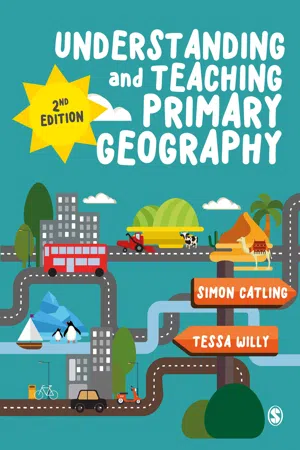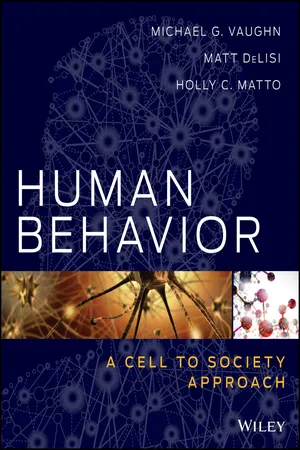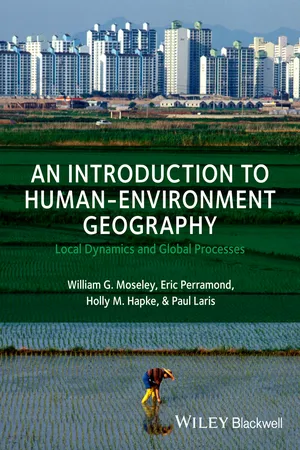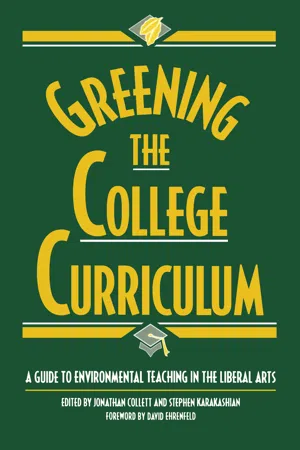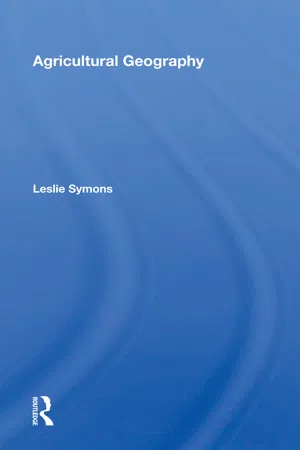Geography
Physical Environment
The physical environment refers to the natural features and processes that make up the Earth's surface, including landforms, water bodies, climate, and ecosystems. It encompasses the interactions between the atmosphere, lithosphere, hydrosphere, and biosphere. Understanding the physical environment is essential for studying geographical patterns, human interactions with the environment, and the impact of natural phenomena on society.
Written by Perlego with AI-assistance
Related key terms
9 Key excerpts on "Physical Environment"
- eBook - ePub
- Simon Catling, Tessa Willy(Authors)
- 2018(Publication Date)
- SAGE Publications Ltd(Publisher)
Physical and human geography appear all around us and are important in our daily lives. The natural world provides us with a wide range of resources that provide the raw materials for bricks, stone, concrete, tiles, wood and glass for buildings, as well as the sources of the metals, plastics and energy from which we manufacture materials and generate electricity. Our mobile phones depend for their materials on the natural environment, but they are also the result of human ingenuity, from design to component manufacture and to sales, supported by the sites of aerials to enable us to keep in touch with each other and with the variety of websites we access. Understanding how our food is grown, the nature and quality of the soil, what optimal agricultural conditions are for different crops and animal husbandry, how food is processed before it reaches us and then the energy we use for cooking, require and integrate many aspects of physical and human geography in describing and explaining what happens, why and with what effect for ourselves and others. Physical and human geographies are key to understanding our everyday lives, just as much as in helping us know about and appreciating the nature, events and activities of the wider world. These two interrelated aspects of geography matter a great deal to us all.Environmental geography
Geographers have always recognised that physical and human geography are inextricably linked and highly dependent upon one another in a dynamic and constantly evolving way. They effect, change and impact on each other continuously and so, within geography, cannot realistically be seen separately, although research on particular topics may give this impression. This interface has been termed environmental geography (Castree et al., 2009), and at times an holistic or unified approach in geography, to describe both the processes and the impact of each aspect on the other (Matthews and Herbert, 2004, 2008). This is indicated in Figure 6.1 . Topics that might be included in environmental geography include climate change and deforestation as well as land reclamation and conservation.An understanding of environmental geography is crucial if we are to appreciate the complexity of the interrelationship of human geography and physical geography and how we can live in a sustainable way on the Earth. While it is important to understand the specific processes in physical and human geography, we also need to help children appreciate the interplay between them, and how that impacts on people’s lives and the Physical Environment in which we live. This can be exemplified through two examples.Figure 6.1 Aspects of physical and human geography and their interface with environmental geographyWhen building a dam to create a reservoir to provide water for settlements, it is crucial to understand the local geology and geomorphology in order to select the best valley site. In the case of a dam built in Andalucía in Spain, the engineers did not appreciate that they were building a dam in a limestone environment and could not understand why it never filled up. The water appeared as a waterfall where the rock type changed over 10km away and the dam became a white elephant and could never be used – it remains there today. Understanding the local geology is fundamental, just as it is essential to know that building a dam directly affects those who live and use the land in the chosen valley site, who will need to be moved out, as well as those who live downstream from the reservoir. It will be essential to do everything to mitigate negative impacts. - eBook - ePub
Human Behavior
A Cell to Society Approach
- Michael G. Vaughn, Matt DeLisi, Holly C. Matto(Authors)
- 2013(Publication Date)
- Wiley(Publisher)
Chapter 12 The Physical Environment In the previous two chapters we examined the fundamental roles of technology and demography and how these core infrastructural domains serve to meet the basic needs of a society. In this chapter we examine the third component of a social system's infrastructure, the Physical Environment. The Physical Environment refers to the natural environment and the built environment. It should be noted that the term ecology is often used interchangeably with these forms of environment. Both forms of environment shape and are shaped by the behavior of humans in myriad ways. Technology and demography are highly intertwined with the Physical Environment and often vary in accord with changes in that environment. Future chapters will continue to deepen the triadic relations of technology, demography, and Physical Environment by examining the role of political and economic institutions and ideology. Knowledge of the interaction between humans and the Physical Environment is an interdisciplinary field of study that, although naturally involving geography, also includes biology, environmental psychology, architecture and design engineering, public health, anthropology, social work, and sociology. The interconnectivity of humans within the Physical Environment, both in the long and short run, is the major theme of this chapter. It delineates specific effects of the natural and built environments and the associated spatial determinants that influence the pursuit of satisfying basic needs and well-being by individuals and collectives. Distal Context Geographic Origins of Inequalities In Chapter 11, we noted the work of Jared Diamond and his seminal work Guns, Germs, and Steel (1997) with respect to the role that technological advances played in facilitating the conquest of the Americas by Europeans - eBook - ePub
- Cynthia Metcalf, Rhonda Atkinson(Authors)
- 2017(Publication Date)
- Research & Education Association(Publisher)
Human Geography focuses on humans and the cultures they create relative to their space. It encompasses population geography, economics, and political geography and looks at how people’s activities relate to the environment politically, culturally, historically, and socially.Physical Geography addresses Earth’s Physical Environment: water (hydrosphere ), air (atmosphere ), plants and animals (biosphere ), and land (lithosphere ). Physical geographers study land formation, water, weather, and climate (weather patterns, specifically precipitation and temperature, over time), as well as more specific topics such as geomorphology, biogeography, and environmental geography.Regional Geography organizes areas of Earth that have some degree of similarity and divides the world into different realms .Topical/Systemic Geography is the orderly and methodical study of climate, landforms, economics, and culture.The main focus of geographers, no matter the subfield, is the spatial perspective. For example, population geography deals with the relationships between geography and population patterns, including birth and death rates. Political geography concerns the effect of geography on politics, especially on national boundaries and relations between states. Economic geography focuses on the interaction between Earth’s landscape and the economic activity of the human population.COMPETENCY 1.1Apply the six essential elements of geography. Geographic Education: 18 Standards, 6 ElementsThe National Geography Standards(http://nationalgeographic.org/standards/national-geography-standards/ - eBook - ePub
An Introduction to Human-Environment Geography
Local Dynamics and Global Processes
- William G. Moseley, Eric Perramond, Holly M. Hapke, Paul Laris(Authors)
- 2013(Publication Date)
- Wiley-Blackwell(Publisher)
relations then the two have been considered separate even if they are not. We accept this distinction only because it is useful as it helps to understand how the world works and our role in it.The Science of Physical Geography
Our inquiry begins with physical geography , which we define as the study of the Earth. Physical geography is not just a catalogue of rivers, forests, mountains, and oceans, but a science that investigates why we find certain features on the Earth where we do and how and why the Earth’s surface changes from day to day, year to year, and over millions of years (Strahler 2011).At a basic level, physical geography is concerned with four realms – the hydrosphere, the atmosphere, the lithosphere, and the biosphere. The hydrosphere (hydro is Greek for water) is water in all its forms, including lakes, rivers, oceans, vapor, and ice. The atmosphere (atmo is Greek for air) is the gaseous layer that surrounds the Earth. It supplies vital elements of carbon, nitrogen, and oxygen to sustain life. The lithosphere (litho is Greek for stone) is the platform of the life layer. It includes solid rock and soil. This layer is sculpted into landforms such as hills and valleys (see Goudie and Viles 2010). Finally, the biosphere (bio is Greek for life) encompasses all living organisms on Earth which depend on the other three layers. Here we focus especially on the last three (atmosphere, lithosphere, and biosphere), and refer you to Chapter 12 on water for more on the hydrosphere and its connections to human–environment relationships.The biosphere, which is the primary focus of this chapter, can be thought of as the life layer . It is a relatively thin layer that includes the surface of the lands and upper surface of the ocean. It is where the other realms come together and interact, and it is also the human habitat.In this chapter we focus on some basic environmental concepts beginning with the two fields that encompass the study of the biosphere, ecology and biogeography. Although both perspectives (or disciplines) concern themselves with the biotic environment, all life is influenced by the abiotic, and the two are explored together. - eBook - ePub
Bringing History Alive through Local People and Places
A guide for primary school teachers
- Lynne Dixon, Alison Hales(Authors)
- 2013(Publication Date)
- Routledge(Publisher)
In this chapter we are primarily concerned with the Physical Environment in which children live and in which some of them have grown up. This Physical Environment is perhaps the most commonly associated with traditional local history. It includes the housing and infrastructure of the locality (road and rail; power and water supplies; schools, libraries, health facilities) plus all the less significant aspects of the Physical Environment – street furniture, monuments, plaques – that make up the material place. These physical surroundings also give clues about the social, cultural and economic environments of a locality. This present day environment is of course entirely a product of the past, distant or more recent; it is in varying degrees of transition, and the Physical Environment is a rich source of evidence for historical enquiry.This approach in local history has its roots in the mid-twentieth century when, in 1955, the local historian W.G. Hoskins wrote the seminal work on the landscape as a source of evidence for learning about the past – The Making of the English Landscape. Looking at both urban and rural landscapes, he demonstrated how to interpret and make sense of the landscape as it has been affected by human activity (Hoskins, 1955). His work has inspired many and he is credited as having pioneered landscape studies and for giving local history, often seen as ‘semi-amateur’, a more academic profile (Ellis, 2005; Taylor, C., 2005; Lively, 2011). Hoskins stressed the importance of using both fieldwork – ‘no historian should be afraid to get their feet wet’ (1984:3) – and maps to tell the story of the local while acknowledging the need for archaeology to fill in aspects of the more distant past. He referred to local history and topography in the same phrase, topography being literally the shape of the earth’s surface (1984). It is an approach which is taken for granted by many local historians today and one which, in an appropriate form, is ideal for children.The physical environs are an important starting point for local history because of the visible and easily accessible nature of the evidence. An awareness of the rich layers of our surroundings can also bring pleasure in its own right. We are certainly aware of the pleasure that the ability to date buildings for instance can bring to children. - eBook - ePub
Greening the College Curriculum
A Guide To Environmental Teaching In The Liberal Arts
- Jonathan Collett, Stephen Karakashian(Authors)
- 2013(Publication Date)
- Island Press(Publisher)
Conservation ideology is in transition. The conventional model—pre—serving nature in parks and reserves entirely isolated from human activities—has proven inadequate. Biologists now recognize that most parks and reserves are too small to support populations of large vertebrates, or to sustain ecological processes that generate and maintain high levels of biodiversity. Numerous case studies of parks in the tropics also prove that prohibiting all human use of protected areas is often socially infeasible. Conservationists have thus turned to a more holistic approach, where ecosystems are managed beyond the scale of a single park, and human resource use is incorporated in management strategies. This broad-scale, integrated approach requires an understanding of how humans adapt to and transform their biophysical environs. But how do we thoroughly evaluate environmental change on a large spatial and temporal scale? How do we distinguish land degradation from sustainable land use? These questions lie at the core of geographic inquiry. Geographers are well suited to explore the interface between local actions and global concerns. Geography leads students to examine the physical and social consequences of human interaction with the biosphere. Geography students also explore the evolution of environmental conservation as an ideology across time and culture. The goal of an introductory geography course is to prepare students to evaluate how they shape their local—as well as global—environment.Emphasis on Spatial Pattern and Focus on Human Agency in Shaping Landscapes
Geography is founded on an age-old intellectual tradition of observing human influence on the bioPhysical Environment. During the past three centuries, as human capacity to alter the environment has escalated in scale, rate, and intensity, geographers have chronicled human degradation of physical habitats (Turner et al. 1992). At the turn of the 18th century, Alexander von Humboldt documented human influence on vegetation in his exploration of remote Andean regions. Sauer (1956, p. 49) later noted the ever-expanding role of humans as “ecologic dominants.” This school of thought persists in geography, characterized by the view that pristine or “untouched” ecosystems are, by and large, nonexistent (Denevan 1992). (See Chapter 2, Anthropology, for further discussion of this perspective.)The approach of geographers to the study of environmental change emphasizes spatial pattern, a large scale of inquiry (over space and time), and the integration of social and natural sciences. Geographers typically conduct research at the level of landscape or region; for example, considering land use patterns and their impact on vegetation in a drainage basin or watershed. Recently, geographers have begun working at much broader scales. Such a study is under way in Mexico, where Liverman (1990) is investigating the capacity of small-scale farmers to cope with climatic change over several decades. Research elsewhere documents local adaptation in land management upon elevated exposure to storms, oil spills, flooding, and other forms of environmental risk (Kates and Burton 1986). - eBook - ePub
- Leslie Symons(Author)
- 2019(Publication Date)
- Routledge(Publisher)
Neither has the availability of increased knowledge and the refinements of seeds, fertilisers, machinery and other inputs and the widening of control and investment by governments diminished the significance of physical factors. More is known about the overcoming of limitations of soil and climate, but on better land costs are still lower per unit produced and rents can still reflect this difference. The occurrence of droughts still results in severely lowered yields, not only in areas where agriculture is still primitive and remedial measures of limited availability, but also in areas such as the U.S.S.R., where vast state resources can be mustered, and in highly developed capitalist societies where personal involvement and managerial skills have been able only to mitigate, not eliminate, the consequences of climatic fluctuation. This is well illustrated in the droughts of the U.S.S.R. in 1975 and in western Europe in 1976. It is thus appropriate at this stage to examine in greater detail the individual factors and forces that make up the Physical Environment which agriculture exploits and with which it has to contend.1 These include Ucko and Dimbleby (eds) (1969), Thomas (ed.) (1956), Clarke (1952).2 Stewart (1956).1 Ueko and Dimbleby (1969).2 Narr (195b).3 Harris (1969).4 Sauer (1952), 23-29.1 Sauer (1952), 72-73.2 Vavilov (1935, 1949-50).1 Murray (1970) summarises the evidence.2 Clarke (1952), 97.3 Evans (1956).1 Heichelheim (1956).1 Slicher van Bath (1963).2 Beresford and St. Joseph (1958) provide an attractive survey.3 Slicher van Bath (1963), 58-59.1 Donkin (1963).1 Slicher van Bath (1963), 244.1 Smith (1949), 23.1 Smith (1949), 44.2 Jordan (1969).1 Perry (ed.) (1973).2 The contribution of Von Thiinen and later workers is reviewed in Chapter 9.3 White (1975), 12.Passage contains an image
CHAPTER 2 Physical Factors influencing Agriculture
The physical factors will be considered under three main headings; climate, soil and relief.Climate
Climate is the principal aspect of the Physical Environment affecting agriculture. The characteristics of the soil, the essential medium for plant growth, are largely the product of present and past climates and the vegetation that has flourished in them, and the effects of relief are to no small degree expressed through resulting climatic variation. - eBook - ePub
- Erin Gibbs Van Brunschot, Leslie W. Kennedy(Authors)
- 2007(Publication Date)
- SAGE Publications, Inc(Publisher)
At various points in this volume, we have referred to the landscape of security, and how it is that certain issues come to the fore while others recede, depending on the perspective one assumes. Undoubtedly, physical bodies play a role in that landscape, with the health of physical bodies an issue at each level of analysis—individual, institutional, and state. The geographic landscape also plays a role in how it is that security is perceived, with risk balance playing out differently depending on the Physical Environment with which one is dealing. Most obviously, those who reside in Kansas and Nebraska, for example, spend less time worrying about tsunamis than they do about tornados. Likewise, urban dwellers on the East Coast may perceive the likelihood of terrorist attack much differently than do farmers in the Midwest.Our consideration of the physical landscape of security continues in the next section. We begin with a quote from a relatively well-known radical environmentalist and continue our examination by reflecting on various approaches to, and definitions of, environmental security. We consider definitions of disasters, and then move to a more deliberate and measured examination of Hurricane Katrina and how this event clearly illustrates risk imbalance, in this particular case, and the impact that this imbalance has had for the security of various stakeholders.The Physical Landscape: The Environment
In my lifetime I have witnessed an onslaught against the inhabitants of this world lead by the greed of industrialized nations. It is my belief that the oppression of people is rooted in the oppression and exploitation of nature. A fundamental disrespect for life that began with the conquest of Mother Nature and has lead to the conquest of humankind. I struck back. In an act of resistance designated to raise awareness and draw attention to a problem that affects every human being, every animal, every plant, and every form of life on this planet. I am speaking of global warming, air, soil and water pollution. We are in the midst of a global environmental crisis. On June 16, 2000 I ignited a fire that would forever change my life. I torched 3 SUV’s. I took extra care and used specific fuels to ensure no one would be injured. (Luers, 2007) - eBook - ePub
Principles and Practices for Response in Second Language Writing
Developing Self-Regulated Learners
- Maureen Snow Andrade, Norman W. Evans(Authors)
- 2012(Publication Date)
- Routledge(Publisher)
Chapter 5
Physical Environment
Objectives
This chapter discusses the principle of Physical Environment and its application to L2 writing, and outlines practices and activities that help learners: •understand how Physical Environment impacts writing performance; •identify environmental factors that contribute to or distract from writing performance; •clarify personal preferences for a positive writing environment; and •develop strategies to avoid internal distractions.Definitions and Applications
The Physical Environment principle of self-regulated learning focuses on location, or where learning takes place (Dembo & Seli, 2008; Zimmerman, 1998). Learners who are able to structure or adapt to their learning environment as needed perform better academically (Dembo & Eaton, 2000; Zimmerman, 1998; Zimmerman & Martinez-Pons, 1986). A detailed discussion and definition of the concept of Physical Environment will help learners understand Physical Environmental factors that impact learning. To understand how physical surroundings influence learning, it is first necessary to identify how they impact a learner's ability to concentrate on learning tasks. What physical elements disrupt concentration, causing learners to refocus attention?Distracters may be external or internal. External factors are generally tangible and can be described using the senses of touch, sight, smell, and sound. External distracters may be in the form of a view out of a window or pictures hanging on the walls, the temperature of the room, the levels and frequency of noise, the type of furniture, the availability of needed materials (pencils, paper, books), the adequacy or lack of lighting, and the cleanliness of the room. Additionally, the time of day can be considered an external factor because any given place may be relatively distraction free and quite suitable for focused learning at one time of day but full of interruptions and unsuitable for focused learning at another time of day. External factors may contribute to or detract from an individual's ability to learn effectively. Minimizing external distractions is key when choosing a Physical Environment for effective learning (Dembo & Seli, 2008; Zimmerman, Bonner, & Kovach, 1996).
Learn about this page
Index pages curate the most relevant extracts from our library of academic textbooks. They’ve been created using an in-house natural language model (NLM), each adding context and meaning to key research topics.
